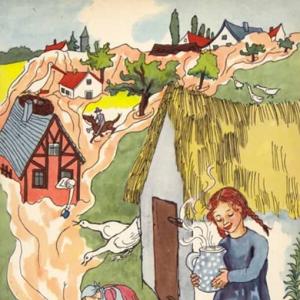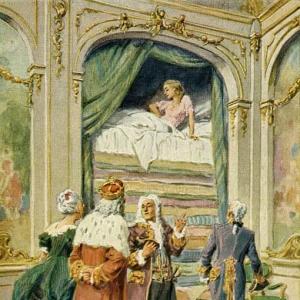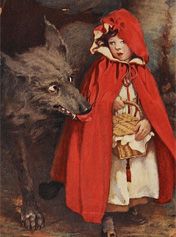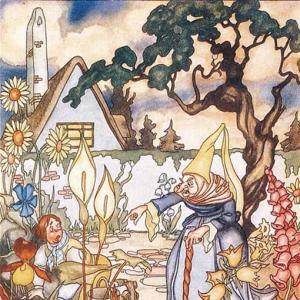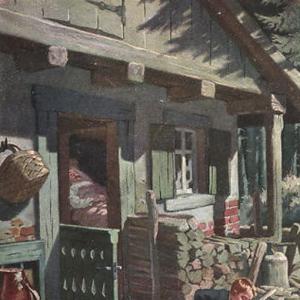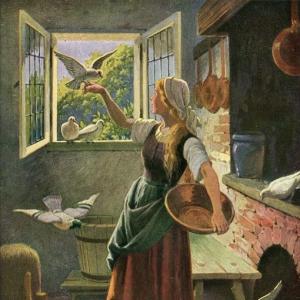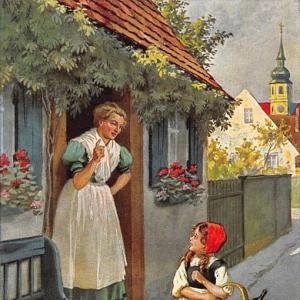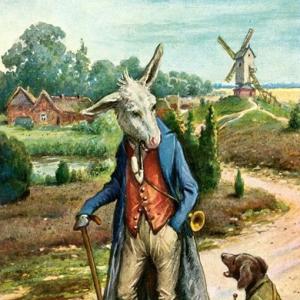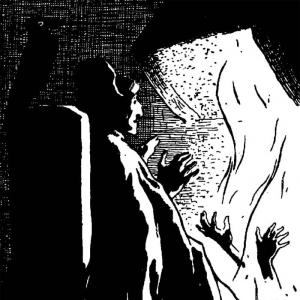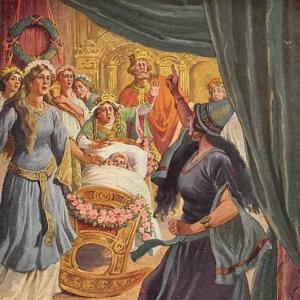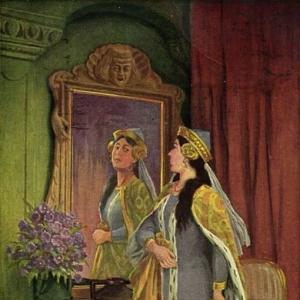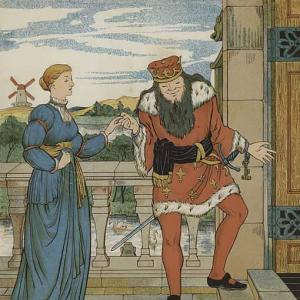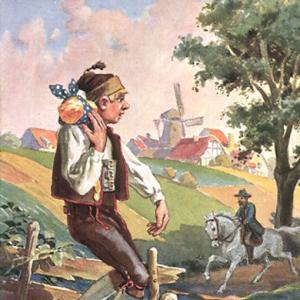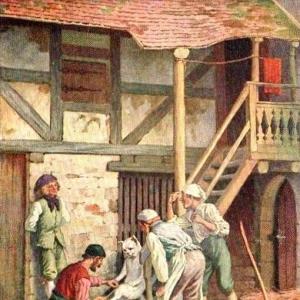Reading time for children: 5 min
There was once a little child whose mother gave her every afternoon a small bowl of milk and bread, and the child seated herself in the yard with it. When she began to eat however, a snake came creeping out of a crevice in the wall, dipped its little head in the dish, and ate with her. The child had pleasure in this, and when she was sitting there with her little dish and the snake did not come at once, she cried,
„Snake, snake, come swiftly
Hither come, thou tiny thing,
Thou shalt have thy crumbs of bread,
Thou shalt refresh thyself with milk.“
Then the snake came in haste, and enjoyed its food. Moreover it showed gratitude, for it brought the child all kinds of pretty things from its hidden treasures, bright stones, pearls, and golden playthings. The snake, however, only drank the milk, and left the bread-crumbs alone. Then one day the child took its little spoon and struck the snake gently on its head with it, and said, „Eat the bread-crumbs as well, little thing.“ The mother, who was standing in the kitchen, heard the child talking to someone, and when she saw that she was striking a snake with her spoon, ran out with a log of wood, and killed the good little creature. From that time forth, a change came over the child. As long as the snake had eaten with her, she had grown tall and strong, but now she lost her pretty rosy cheeks and wasted away. It was not long before the funeral bird began to cry in the night, and the redbreast to collect little branches and leaves for a funeral garland, and soon afterwards the child lay on her bier.
Second Story.
An orphan child was sitting on the town walls spinning, when she saw a snake coming out of a hole low down in the wall. Swiftly she spread out beside this one of the blue silk handkerchiefs which snakes have such a strong liking for, and which are the only things they will creep on. As soon as the snake saw it, it went back, then returned, bringing with it a small golden crown, laid it on the handkerchief, and then went away again. The girl took up the crown, it glittered and was of delicate golden filagree work. It was not long before the snake came back for the second time, but when it no longer saw the crown, it crept up to the wall, and in its grief smote its little head against it as long as it had strength to do so, until at last it lay there dead. If the girl had but left the crown where it was, the snake would certainly have brought still more of its treasures out of the hole.
Third Story.
A snake cries, „Huhu, huhu.“ A child says, „Come out.“ The snake comes out, then the child inquires about her little sister: „Hast thou not seen little Red-stockings?“ The snake says, „No.“ – „Neither have I.“ – „Then I am like you. Huhu, huhu, huhu.“
 Learn languages. Double-tap on a word.Learn languages in context with Childstories.org and Deepl.com.
Learn languages. Double-tap on a word.Learn languages in context with Childstories.org and Deepl.com.Backgrounds
Interpretations
Adaptions
Summary
Linguistics
„Stories about Snakes“ is a compilation of three short tales written by the Brothers Grimm, Jacob (1785-1863) and Wilhelm Grimm (1786-1859). The Brothers Grimm were German authors and philologists known for their collection of fairy tales and folklore, which aimed to preserve traditional oral stories in written form. Their collection of stories, titled „Kinder- und Hausmärchen“ (Children’s and Household Tales), was first published in 1812 and went through numerous editions, revisions, and expansions over the years. The stories are now commonly known as „Grimm’s Fairy Tales.“
The Brothers Grimm were scholars and academics who had an interest in folk culture, linguistics, and the history of the German people. Their work as philologists contributed significantly to the development of the field of German linguistics. Their most famous work, however, remains the collection of fairy tales that have become an integral part of Western literature and popular culture.
„Stories about Snakes“ is one of the lesser-known works from their collection and does not have the same popularity as stories like „Cinderella,“ „Hansel and Gretel,“ or „Snow White.“ The three short tales in this compilation are not as elaborately constructed as some of the other Grimm fairy tales, but they share similar themes and motifs commonly found in their works. The stories explore relationships between humans and animals, the consequences of actions, and the importance of understanding and compassion.
The three short tales in the „Stories about Snakes“ by Brothers Grimm can be interpreted in different ways, with themes of friendship, gratitude, greed, and the consequences of one’s actions.
The first story can be interpreted as a tale about the bond between the young girl and the snake. Their friendship brings joy and prosperity to the girl’s life, but her mother’s misunderstanding of the situation leads to tragic consequences. This story highlights the importance of understanding and accepting unusual friendships and the negative impact that fear and prejudice can have on relationships.
In the second story, the girl’s encounter with the snake can be seen as a commentary on greed and missed opportunities. The girl is initially rewarded for her kindness by receiving a valuable gift, but her desire for more leads her to take the crown. The snake’s tragic death illustrates the consequences of the girl’s actions and serves as a reminder that greed can have unintended consequences. This story teaches the importance of contentment and valuing the gifts one receives.
The third story is a brief, almost whimsical, interaction between a child and a snake. The child is searching for her little sister, and the snake, unable to help, shares in her sadness. This story might be seen as a reflection on empathy and the universal experience of loss. Even though the snake and the child are different creatures, they can still connect on an emotional level and share their feelings.
„Stories about snakes“ is a lesser-known fairy tale from the Brothers Grimm collection, and as such, it has not been adapted as widely as some of their more famous tales. However, here are a few adaptations of the story that have been created:
„The Snake Prince“ by Daniel Wallace: This modern retelling of the story features a young woman named Lolly who discovers a snake in her bathtub. She befriends the snake and learns that he is actually a prince under a curse. Lolly helps the prince break the curse and they fall in love. The story emphasizes the power of love and the importance of seeing beyond appearances.
„The Serpent Slayer“ by Kat Howard: This short story is a dark and twisted adaptation of „Stories about snakes“. The tale follows a young woman who becomes obsessed with killing snakes after her sister is bitten and dies. However, her quest for revenge leads her down a dangerous path, and she must face the consequences of her actions. The story explores themes of revenge and the consequences of violence.
„The Girl Who Spun Gold“ by Virginia Hamilton: This retelling of the Rumpelstiltskin story includes elements of „Stories about snakes“. The story follows a young woman who is able to spin straw into gold with the help of a magical snake. When she becomes greedy and forgets to thank the snake, she loses her gift and must find a way to regain it. The story emphasizes the importance of gratitude and the power of storytelling.
„The Gift of the Magi“ by O. Henry: This short story is not a direct adaptation of „Stories about snakes“, but it shares a similar theme of the consequences of selfishness. The story follows a young couple who are willing to sacrifice their most prized possessions to buy Christmas gifts for each other. However, their sacrifices lead to unexpected consequences. The story explores the nature of sacrifice and the true meaning of love.
Overall, „Stories about snakes“ has not been adapted as widely as some of the other Grimm fairy tales, but it has inspired a few creative retellings that explore themes of love, revenge, gratitude, and sacrifice.
„Stories about Snakes“ is a collection of three short tales by the Brothers Grimm, each involving a snake and a child.
In the first story, a young girl shares her daily meal of milk and bread with a snake. The girl and the snake enjoy each other’s company, and the snake brings her precious gifts from its hidden treasures. The girl grows tall and strong as long as the snake eats with her. One day, the girl playfully taps the snake with a spoon, encouraging it to eat the bread crumbs as well. Her mother sees the snake and, fearing for her daughter, kills it. The girl’s health rapidly deteriorates after the snake’s death, and soon she passes away.
In the second story, an orphan girl spots a snake emerging from a hole in the town wall. She lays out a blue silk handkerchief to attract the snake, which is known to be drawn to such items. The snake brings a small golden crown and places it on the handkerchief before leaving. The girl takes the crown, and when the snake returns to find it missing, it grieves by repeatedly hitting its head against the wall until it dies. If the girl had left the crown, the snake would have likely brought more treasures.
In the third story, a snake cries out, and a child responds by asking if it has seen her little sister, „Red-stockings.“ The snake replies that it hasn’t, and the child says she hasn’t either. The snake then echoes the child’s sentiment, expressing their shared situation with a sorrowful „huhu.“
The Brothers Grimm fairy tale „Stories about Snakes“ showcases recurring themes of innocence, trust, betrayal, loss, and the interplay between humans and nature. Linguistic analysis of this tale reveals insights into the use of language to create mood, characterize, and convey moral lessons.
Dialogue and Direct Speech: The use of direct speech, such as the child calling the snake with a rhyme, adds a rhythmic and lyrical quality to the story. This device serves to engage young listeners, as fairy tales were traditionally told orally. The simplicity of the child’s speech reflects her innocence and highlights the bond she forms with the snake. This is contrasted sharply with the abrupt and action-driven speech of the mother.
Repetition: The repetition of actions and phrases (e. g. , the child’s call to the snake, the snake bringing treasures) creates a sense of familiarity and expectation. Repetition is also a common stylistic choice in fairy tales to aid memory retention.
Symbolism: Snakes in literature often symbolize duality – they can be both beneficent and maleficent. In this tale, the snake is portrayed as a benign and generous creature, subverting typical snake symbolism that usually leans towards deceit and evil. The treasures the snake brings signify the reward of kindness and the snake’s gratitude, while the child’s wasting away symbolizes the consequences of breaking trust and harmony between nature and humans.
Descriptive Language: Vivid descriptions, such as „bright stones, pearls, and golden playthings,“ evoke a sense of wonder and enchantment. These descriptive choices create a magical atmosphere typical of fairy tales.
Moral and Didactic Tone: The narrative imparts moral lessons, such as the importance of kindness and the risks of greed or misunderstanding, through its outcomes. The mother’s action leads to a tragic result, underlining the moral that destructive human interference can lead to loss.
Personification: The snake is personified, capable of gratitude, generosity, and even emotions like grief. This anthropomorphism helps convey the human-like relationships shared between the child and the snake, making the tragedy of their separation more poignant to the audience.
Analysis of Themes
Innocence and Corruption:
The child’s innocence is a significant theme, depicted by her simple request for the snake to enjoy the bread. The mother’s corruption of this innocence and the resulting tragedy suggest a critique of adult interference in the natural, innocent world of children.
Interaction with Nature:
The stories suggest a harmonious relationship with nature can be rewarding but is fragile and easily disrupted by human misunderstanding or greed.
Loss and Mourning:
The imagery of funeral preparations by birds emphasizes the profound loss felt by nature itself when harmony is disrupted, reinforcing the interconnectedness between humans and nature.
Overall, the linguistic elements and themes in the Brothers Grimm’s „Stories about Snakes“ combine to create a narrative that is both enchanting and cautionary, inviting reflection on human actions and their impacts.
Information for scientific analysis
Fairy tale statistics | Value |
|---|---|
| Number | KHM 105 |
| Aarne-Thompson-Uther-Index | ATU Typ 285 |
| Translations | DE, EN, DA, ES, PT, FI, IT, JA, NL, PL, RU, TR, VI, ZH |
| Readability Index by Björnsson | 28.5 |
| Flesch-Reading-Ease Index | 84 |
| Flesch–Kincaid Grade-Level | 6.3 |
| Gunning Fog Index | 8.8 |
| Coleman–Liau Index | 8.3 |
| SMOG Index | 7.5 |
| Automated Readability Index | 7.5 |
| Character Count | 2.767 |
| Letter Count | 2.124 |
| Sentence Count | 27 |
| Word Count | 519 |
| Average Words per Sentence | 19,22 |
| Words with more than 6 letters | 48 |
| Percentage of long words | 9.2% |
| Number of Syllables | 634 |
| Average Syllables per Word | 1,22 |
| Words with three Syllables | 15 |
| Percentage Words with three Syllables | 2.9% |

